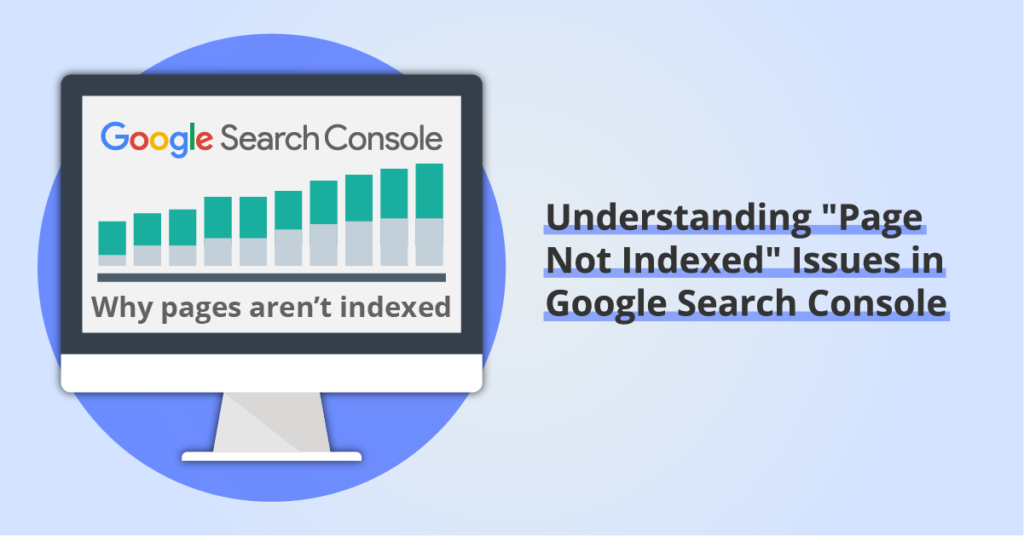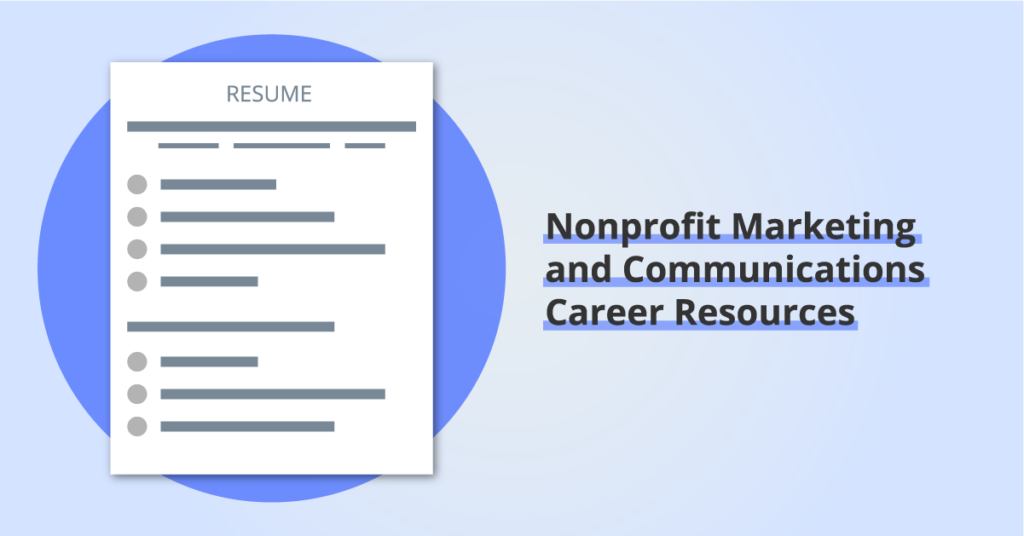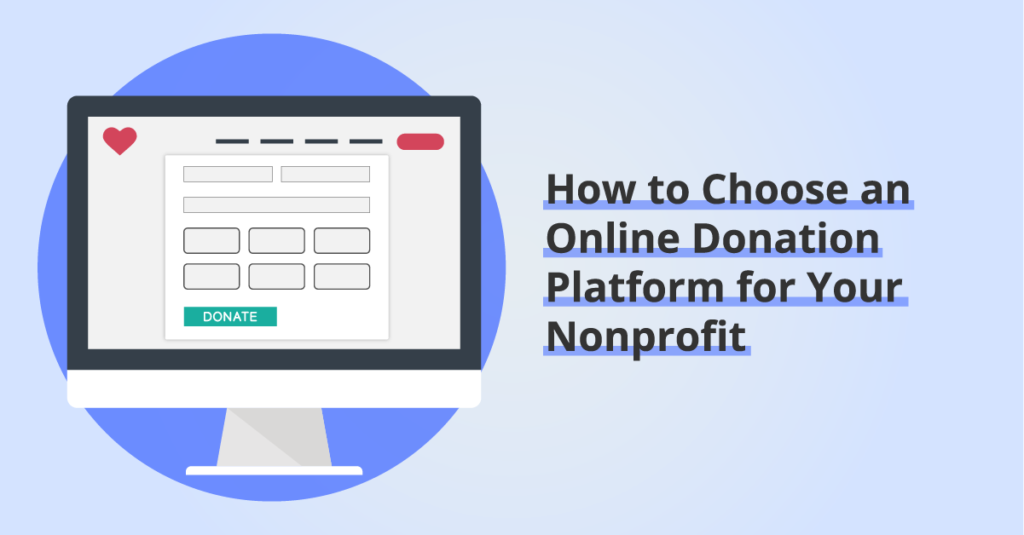SEO for Nonprofits: 8 Steps to Create Your SEO Strategy
By: Ed Harris / Published: March 6, 2023 / Last updated: June 27, 2024
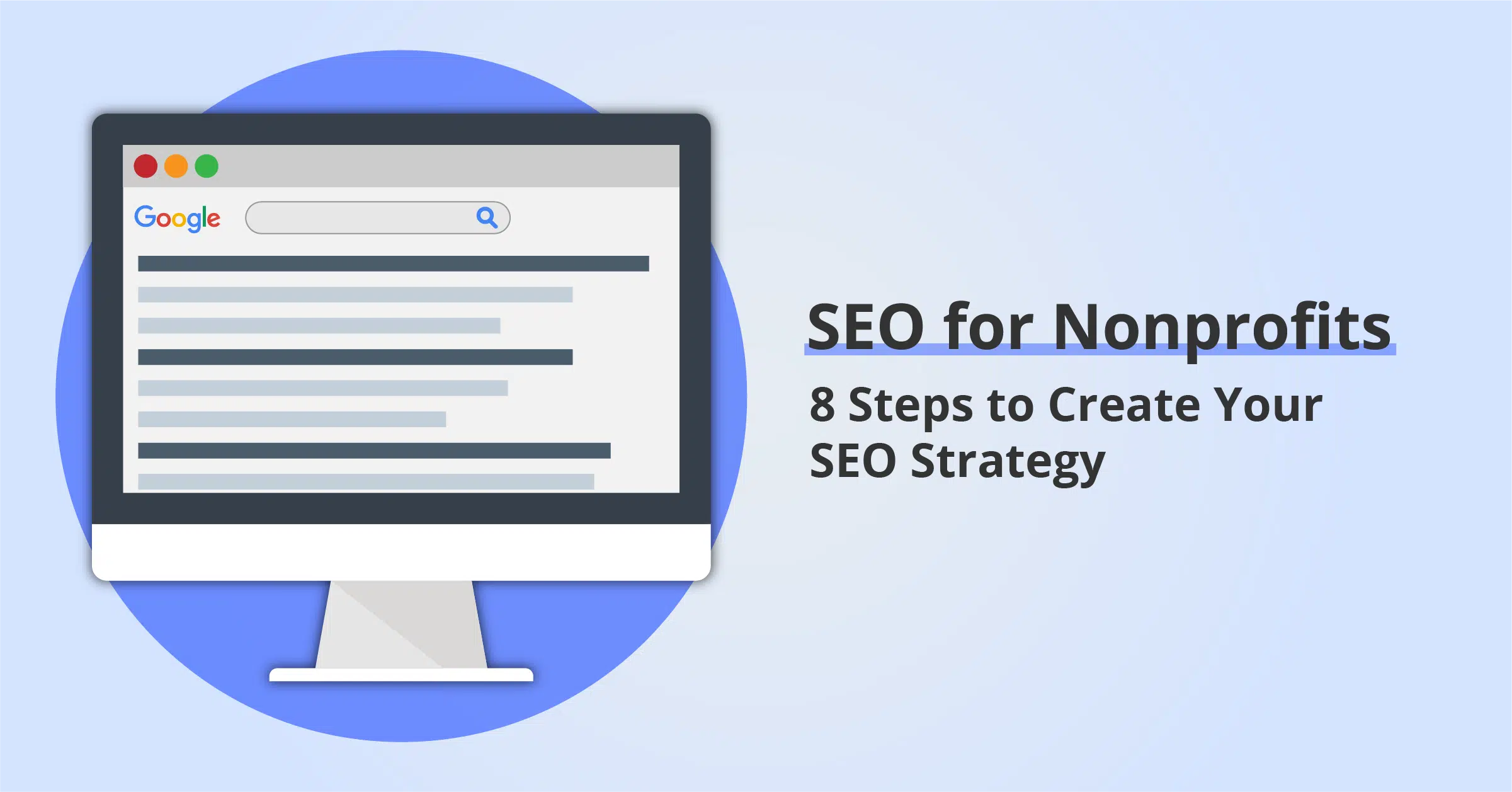
What is SEO for nonprofits?
Search engine optimization (SEO) for nonprofits or charities is the process of improving website content to increase visibility in organic search results, and drive more relevant traffic from visitors interested in your cause, who may become volunteers, program participants, or donors.
Before we dig in to building your nonprofit SEO strategy, let’s review some fundamental details about how SEO works.
Disclosure: some of the links below are affiliate links, meaning that at no cost to you, we will earn a commission if you click through and make a purchase. Learn more about the products and services we recommend here.
What is SEO?
SEO stands for Search Engine Optimization. It refers to activities intended to:
- Increase the visibility of a website’s pages in organic (unpaid) search engine results, and
- Attract visitors to your website from organic search results.
In addition to SEO, we want to introduce one other acronym. SERP stands for Search Engine Results Page. The screenshot below shows the SERP for the Google search query wildfire relief.
A few important features of the SERP to notice:
- Paid ads are often included in the search results, and are marked with the word “ad”. Paid results are often displayed at the top or the bottom of the SERP.
- Organic results refers to all the links on the SERP that are not the result of paid advertising. Depending on the SERP, these may include links, images, videos, products, and more.
- Google also adds other features to SERPs to enhance results or help users find related content. This example includes a “People also ask” section of related questions.
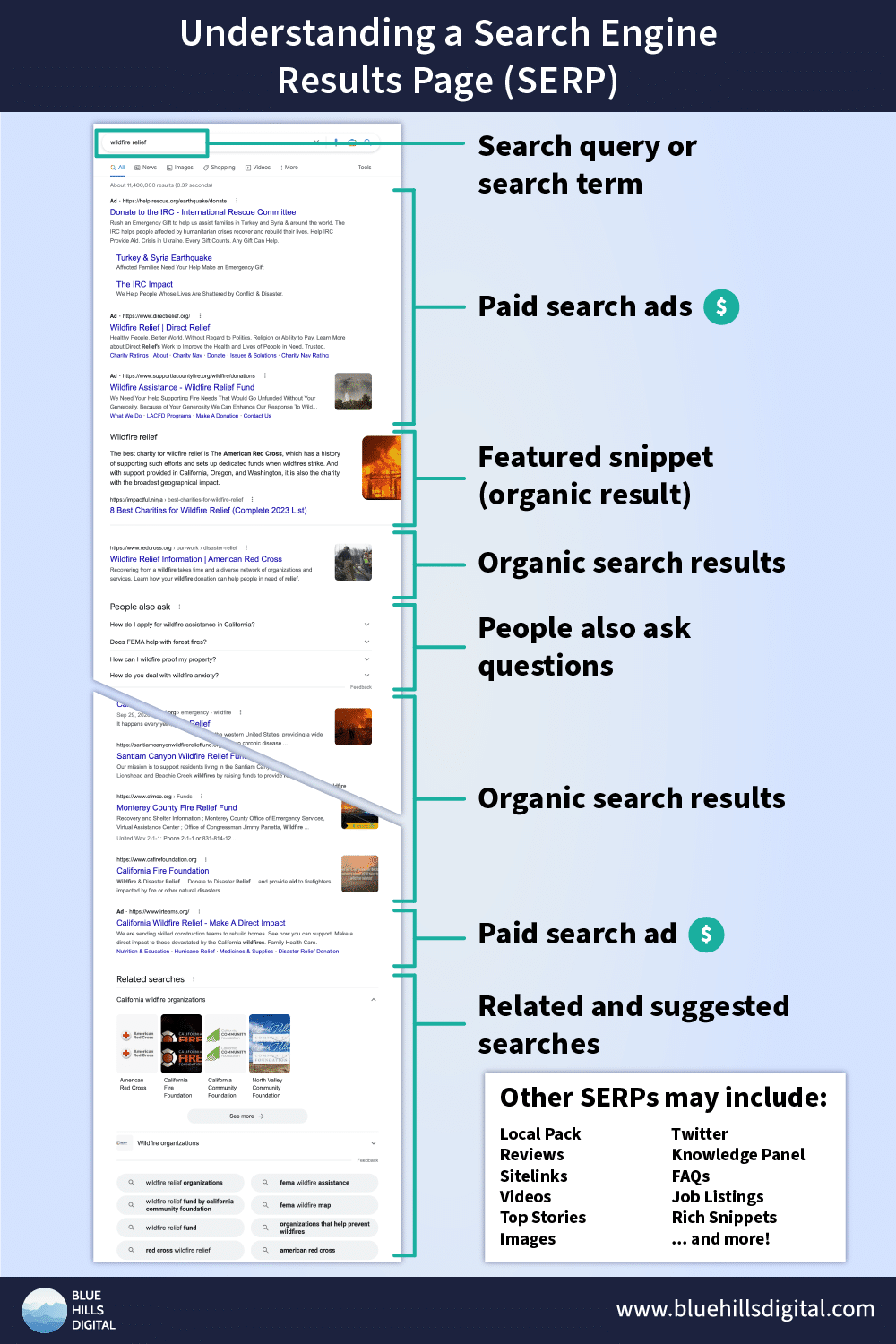
The features Google displays on the SERPs changes frequently, even for the same search query. Check this article from Semrush for more detail on SERP features that are common in 2023.
To see these frequent changes in action, click here to check the current Google search results for the same wildfire relief keyphrase pictured above. We can bet on those results being different. The SERPs are very dynamic, both because of shifting SERP features and because the indexed content itself is constantly changing as new URLs are published.
How does SEO work?
If search engine optimization is about increasing the visibility of URLs from your website in the search results, then we need to start by understanding how search engines decide which pages to include. To keep things simple, we’ll focus on Google, the giant of the search engine landscape.
When a user types (or speaks) a search term into Google, the search engine does its best to understand the user’s search intent. For example:
- Is the user looking for an answer to a question or researching a topic? (Informational intent)
- Are they trying to navigate to a specific website? (Navigational intent)
- Are they trying to buy something or complete a transaction? (Commercial intent)
Then Google’s algorithm gets to work, retrieving the URLs from its index that it thinks will best serve the user’s search intent.
Google does not reveal the ranking factors used to determine how search engine results pages (SERPs) for specific queries are assembled. However, SEO professionals and Google representatives often share advice about the top factors that determine SERP placement. Here are some of the top factors as identified in a comprehensive study published by Search Engine Journal:
- High quality content. Humans and search engines are looking for high-quality content. Increasingly, search engines are looking for evidence of Experience, Expertise, Authority, and Trustworthiness (E-E-A-T) when evaluating content’s ranking potential.
- A good user experience, particularly on mobile devices. This means web pages must be easy to use on mobile devices, should load and become interactive quickly, and remain stable in their layout.
- Pages should be well structured. Commonly referred to as on-page optimization, content on pages needs to be well organized and marked up in a way that is readable to humans and bots/crawlers.
- Links to other relevant, quality content. Internal and external links are important. Links are the connections that both humans and search engine crawlers follow to discover related webpages, both within a single website and between different websites.
- Location. Search engines can factor in the searcher’s location, and if relevant, tailor the results by geography. You’ll be familiar with this from seeing Google return local businesses or organizations based on your location for some searches.
The Google Search Central blog is another source you can use to keep track of updates to how Google Search works. For example, here’s the announcement when the experience “E” was added to the existing E-A-T concept at the end of 2022.
Frequently asked questions about SEO for nonprofits
Here are some answers to other frequently asked questions about SEO for nonprofits and charities:
Search engines are central to how people — think donors, funders, program users — research topics, find information, and decide how and where to spend their time and money. Investing in SEO can increase trust in your organization, attract new donors and supporters, and establishyour organization as a go-to, trusted source for information about your cause.
Yes! Establishing a robust organic search presence is an increasingly important factor in establishing trust with visitors who are learning about your organization for the first time. And more importantly, paying attention to SEO can dramatically increase your organization’s visibility over time, bringing new users, new donors, and increased coverage to your cause, work, and impact.
Improving your nonprofit’s SEO involves research, updating and creating new content for your website, and adding some activities to your broader marketing and communications strategy. Learn more about this steps in our nonprofit SEO strategy guide below.
Developing your nonprofit SEO strategy: Our 8-step guide
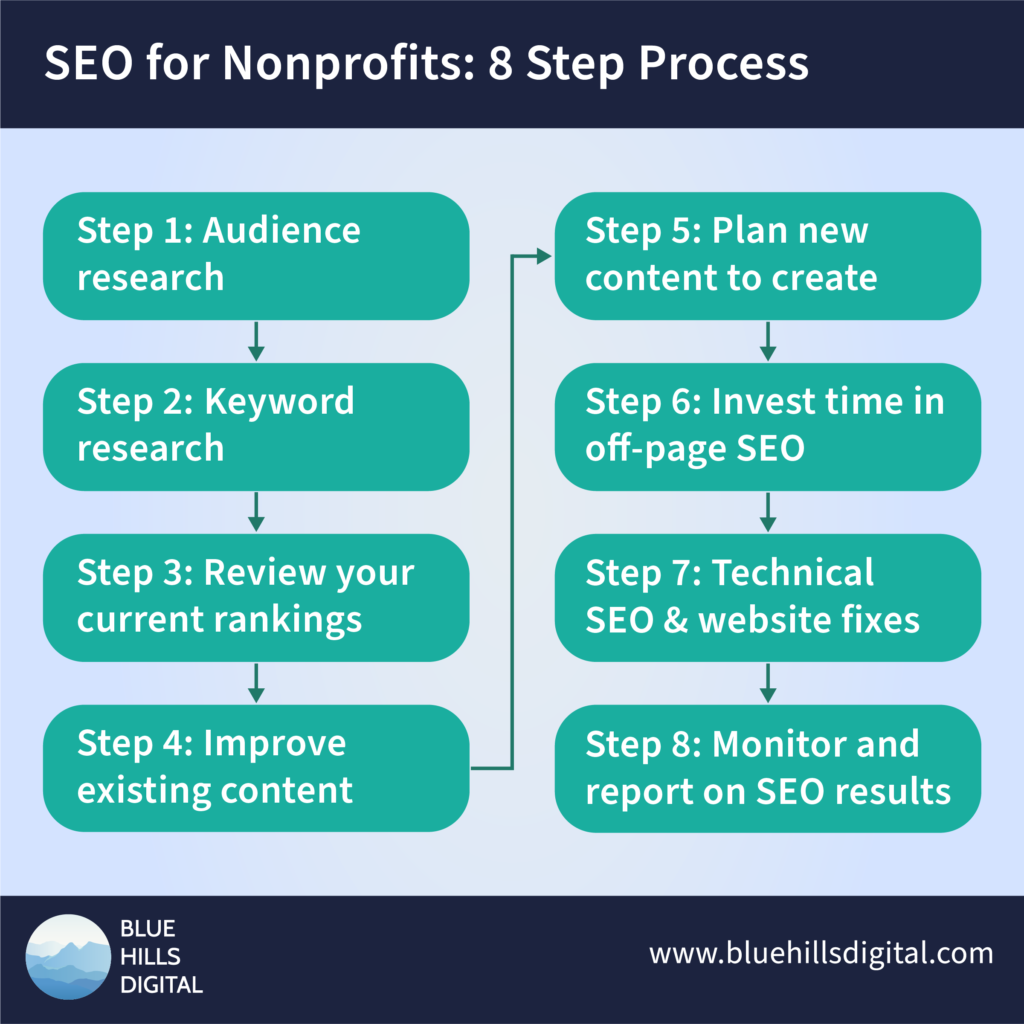
Step 1: Audience research
The first step in building an SEO strategy for your nonprofit organization is understanding your audience (or audiences). You may have already conducted audience research for your organization’s strategic plan, marketing communications plan, or audience journey planning. If so, great — you can draw on that audience research here.
When someone opens up a search engine like Google in their browser, they want something: this is where those categories of search intent that we introduced above are relevant. To be successful in SEO, we need to understand the searcher’s intent. You need to map out your audiences and brainstorm what kind of searches they might be conducting.
- Informational intent searches: what kind of information might your audience members be looking for in relation to your cause, or the work your nonprofit does? Are there questions you can answer, or resources you can offer in a way that matches the informational intent behind those searches?
- Commercial intent searches: are your audience members searching for opportunities to support a particular cause, or make a donation? Can you establish your organization as an authoritative, trustworthy recipient for donor-dollars to support work in your field?
- Navigational intent searches: these searches require less research because they are typically for variations of your organization’s name, or for the names of any branded programs or services that you offer. The searcher is already brand-aware, and is simply using the search engine as a quick way to get to your website. However, it is still worth including this type of search query in your review.
Step 2: Keyword research
Use keyword research tools to start building a list of keywords (or keyphrases) to monitor and track in your SEO work. Your target keyword list will include:
- Keywords you want to rank for in organic search, and
- Keywords that pages on your website already rank for and you want to retain or improve those rankings.
A great place to start your keyword research is by researching around a “seed keyword”, such as the cause your nonprofit addresses. Tools like the Semrush Keyword Magic Tool allow you to start with a seed keyword and review lists of related keywords, keyphrases, and questions around that topic.
Here’s an example keyword magic tool starting point for an organization working on domestic violence:
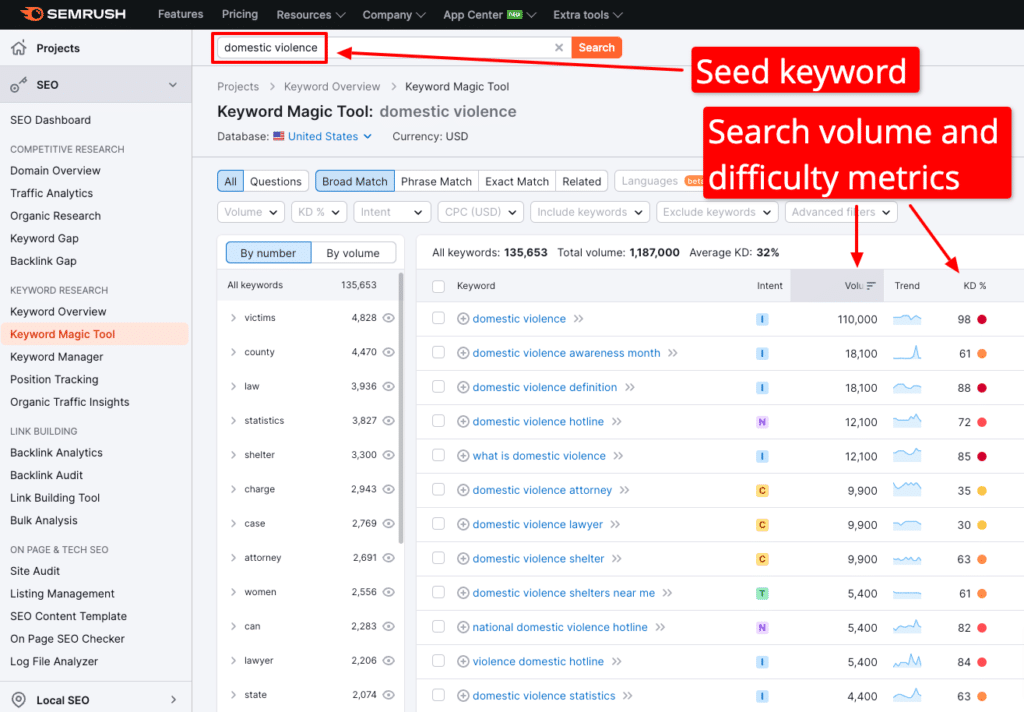
In the example above, Semrush provides approximate search volumes for each related keyword (per month), and a Keyword Difficulty score (1-100). The higher the keyword difficulty score (orange and red dots), the more competitive the search results are and the harder it would be for a new piece of content to rank highly. This is especially the case if the website is a relatively recent and/or hasn’t established a high level of domain authority yet.
Since all the keyword difficulty scores are high in this first example, it’s worth going a little deeper and running the keyword magic tool on a longer tail (more specific) keyword.
Here are the results for the keyphrase “domestic violence prevention”:
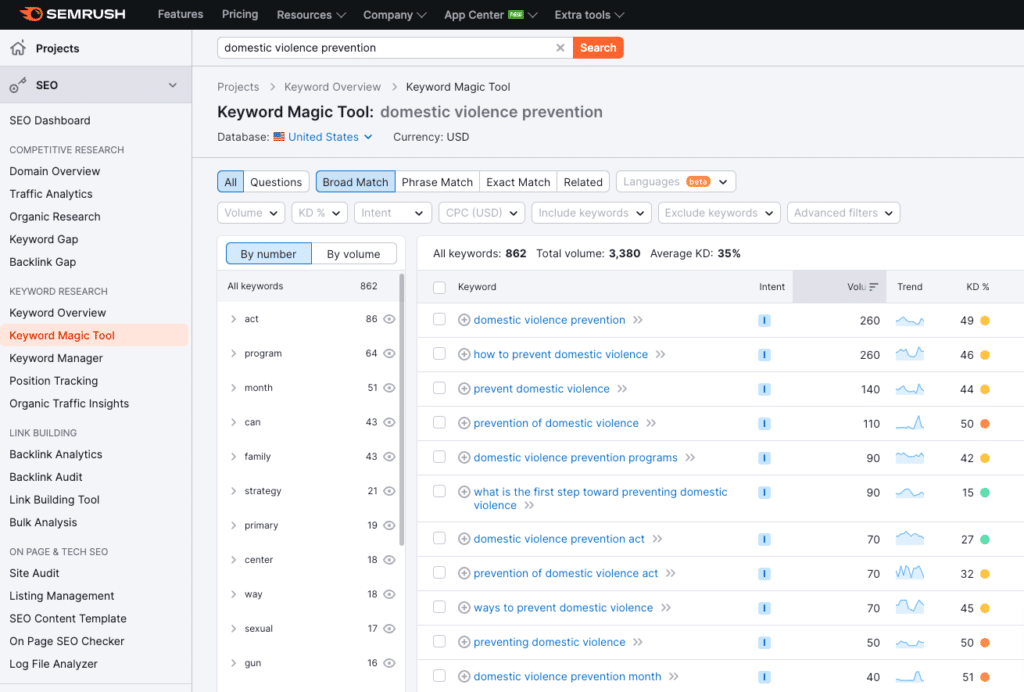
In this example, keyword difficulty scores are lower and you can see some informational queries that a nonprofit organization focusing on domestic violence prevention could target for new content development in an SEO strategy.
Another helpful source of keyword ideas is AlsoAsked, which mines the related questions Google suggests in the “People Also Asked” feature on Search Engine Results Pages. Here’s an example report from AlsoAsked for the domestic violence Google SERP:
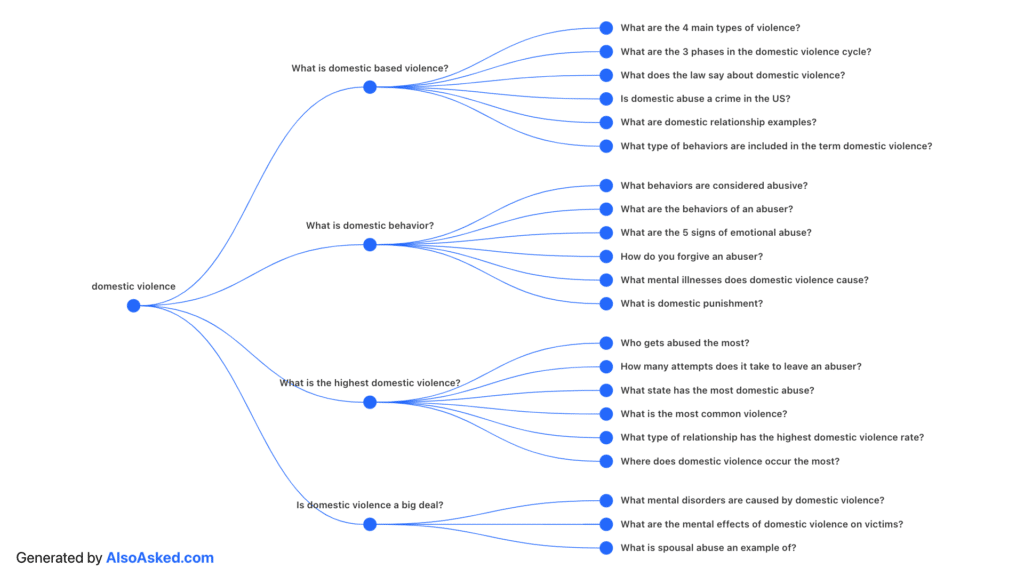
Many of these questions could serve as starting points for blog posts designed to answer informational queries relevant to the organization’s work.
Finally, don’t forget to add your branded keywords to the list. These include your organization’s name (including abbreviations), the names of any significant programs, services, or events that users might be searching for, and the names of any prominent staff members that have a significant public profile.
Step 3: Review your current rankings
As you conduct your keyword research, add your keywords to a target keyword list. You can main this list in a spreadsheet, or you can use the built in keyword list management features in tools like Semrush or SE Ranking. The advantage of these paid tools is that they will track your website’s ranking position for each keyword over time.
Start by reviewing where URLs from your website are currently ranking, both for keywords on your target list and for other URLs. The tools linked above will help with this task, and you can also use free tools like Google Search Console to explore organic search ranking data.
Step 4: Improve existing content
Yes, SEO is closely tied to content marketing, which leads many marketers to try and produce as many new blog posts as possible.
However, the O for Optimizing in SEO reminds us to pay attention to our existing content. If there are URLs that are already ranking and could be optimized to move them into a higher position on the SERP, do this first!
Remember: the click through rate (CTR) of URLs included in the SERPs goes down dramatically after the first few organic results. Data from Advanced Web Ranking’s Click-Through Rate study shows a 41% CTR for the first organic result, which drops to just 6-12% for positions 2-5.

This means it is worth identifying existing content that ranks in positions 6-10 where an incremental improvement could generate a significant increase in traffic.
For example, if your URL that is currently in position 9 for a high-priority keyword could be optimized to move up to position 3, you could see your CTR move from 3% to 8%.
And optimizing a URL that currently ranks somewhere below position 11, simply moving to positions 6-10 could start generating some organic traffic where previously there was none.
To understand how to improve the ranking of an existing URL for a specific keyword, follow these steps to check out the current SERP for that search term:
- Open an incognito or private browser window
- Search Google for the term
- Review the SERP and take note of which features Google includes. If the top results include images or video, your URL will likely need images or video to compete. If Google includes People Also Asked questions, review those questions to get ideas about sub-headings or sections to add to your content.
- Open the URLs that are already ranking above your URL in new tabs. Review the content of each URL that is currently outranking yours and takes notes about the structure and sub-headings, and what content they include.
Your page will need to provide similar topic coverage, and demonstrate greater experience, expertise, authority, and trustworthiness in order to move up the rankings.
Step 5: Plan new content to create
For target keywords on your list that don’t already have organic search rankings you’ll need to plan new content to develop.
If the target keywords are informational and your website includes a section where you publish blog posts or articles, use upcoming blog posts to answer these informational intent searches. The call-to-action on these posts might be to download a free resource, participate in an advocacy action, sign a petition, or subscribe to your organization’s email list.
For keywords with a more commercial or transactional intent, you may want to develop pages within your website navigation hierarchy to target these queries. For example, if your environmental protection nonprofit offers volunteer opportunities you may want to develop an evergreen “Volunteer Opportunities” page that you optimize to rank for the search term environmental volunteer opportunities in [your city]. This page would allow visitors to learn more about volunteering with your organization and convert directly into volunteer leads using a form on the page.
To plan your new content, follow the same process outlined in the Step 4 above to understand the competitive landscape. In comparison to the pages currently ranking for your target keyword, your new piece of content will need to provide similar topic coverage, and demonstrate greater experience, expertise, authority, and trustworthiness in order to move up the rankings.
For example, let’s return to our earlier example of the nonprofit organization working in domestic violence prevention. Keyword research revealed that the keyphrase domestic violence protection act has approximately 70 searches each month and only has a 27% keyword difficulty score. This is a good topic for an informational blog post for an audience that is interested in legislative advocacy relating to domestic violence.
For a given keyword, you can use a tool like Semrush to get a quick overview of the URLs included in the current SERP with the Keyword Overview tool:
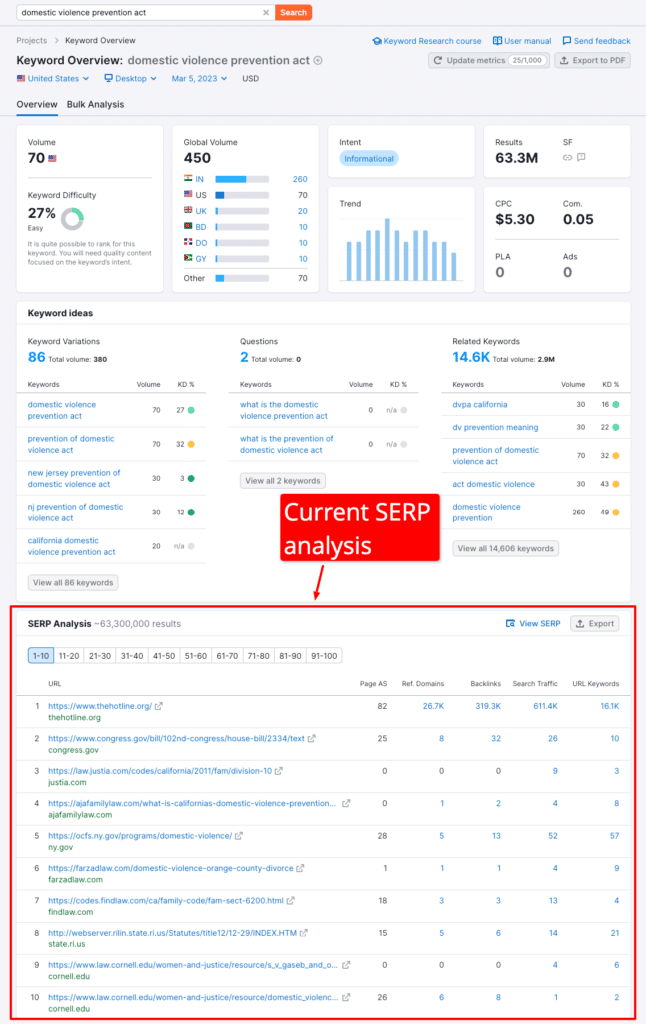
In this example, the top ranking pages aren’t necessarily the most helpful for this search query, since the federal Domestic Violence Prevention Act from 1991 was not passed into law, and the most relevant federal law is in fact the Violence Against Women Act (VAWA). However, several states have passed laws that include the term “Domestic Violence Prevention”.
This creates a strong opportunity to produce a piece of content that explains the legal landscape for these laws, with information about the Federal bill and the various state bills that share this title. The resulting informational article would then be a great jumping-off point for an advocacy-related call to action, or to invite readers to support the organization’s work with a donation.
Step 6: Invest time in off-page SEO
Improving existing content and creating new content are both examples of on-page SEO: optimizing pages on your website to improve search visibility.
Off-page SEO refers to tactics that improve your search visibility beyond your website. Most off-page SEO tactics aim to demonstrate your experience, expertise, authority, and trustworthiness (E-E-A-T) by being an active part of broader online conversations about your topic. Examples include:
- Earning links back to your website, ideally from other authoritative or prominent websites in your niche
- Writing guest posts for other relevant websites
- Appearing as a guest on relevant podcasts or YouTube shows
- Speaking at conferences or other events
- Publishing on social media or relevant online forums
- Pursuing earned media opportunities, being interviewed by journalists, or writing op-ed contributions
- Sponsoring relevant events
Building high-quality links back to your website is an important part of helping Google understand that your organization (as a publisher) is a trustworthy source of information about your cause or topic.
Note: never pay for backlinks. Google states clearly that purchasing backlinks to improve your search rankings is a form of link spam, and sites are routinely penalized for engaging in link spam.
Step 7: Technical SEO — Make sure your website isn’t holding you back
As you work on on-page and off-page SEO, you also need to make sure there aren’t technical issues with your website that could limit the success of your SEO strategy. Technical SEO generally falls into two categories:
- Making sure Google (and other search engines) can effectively discover, crawl, and index new URLs on your site.
- Ensuring your site provides a good user experience: pages should load quickly, be usable on mobile devices, and conform to accessibility best practices.
Tools like Semrush and SE Ranking provide website audit functionality that will highlight some potential technical issues. You can also verify your website with Google Search Console to be alerted to any potential indexing issues.
We provide a longer website audit checklist in this guide, that introduces topics like web accessibility, mobile responsiveness, and more.
Step 8: Monitor and report on your SEO results
As you start work on optimizing your website for search visibility you’ll want to be able to monitor your progress and generate reports.
We suggest monitoring data from three sources:
- Google Search Console: monitor impressions, clicks, click-through rate and average position data by query and by URL. Remember that unless you apply filters, Google Search Console will provide data on ALL Google searches within the time period selected (not just the specific keywords you have chosen to target).
- Keyword tracking tool: use a tool like Semrush or SE Ranking to monitor the positions of a specific set of keywords you have chosen to target. These tools will let you narrow the focus to just the specific keywords you’re working towards rank for (or improve your rankings for).
- Google Analytics: use Google Analytics to monitor the overall volume of traffic coming from organic search, and the conversion rate of traffic coming from organic search. While it’s great to see more traffic coming to your website from organic search, effort spent on SEO is only worthwhile if you can tie that search visibility increase back to you organization’s strategic goals. This means you will need to set up custom conversions in Google Analytics for events like email subscriptions, form submissions, resource downloads, event registrations, or donations.
SEO for nonprofits: Resources, people, and budget
Developing and implementing an SEO strategy at your nonprofit will take some investment: primarily people-hours, and some limited budget to invest in SEO tools.
We’ve recommended a few helpful tools that we use with our clients in this article, and there are many others you may want to explore.
If your internal marketing communications staff doesn’t have the expertise or the time to manage all aspects of an SEO initiative, you may need support from external contractors. We have a couple of suggestions about that here:
It can be tempting to outsource writing blog posts or articles to a contractor in order to meet your content production goals. Our recommendation is that you try to produce your content in-house, even if that means you publish less frequently. High-quality content means demonstrating you have the Experience, Expertise, Authority, and Trustworthiness to win that top ranking spot in the Google search results. If your content is written by an external writer who is not a subject matter expert, it will show. Try to collaborate with internal subject matter experts: try recording a conversation with your CEO or Executive Director and using that content to create a ghost-written article for their approval.
A nonprofit SEO consultant can help conduct your audience and keyword research, provide a content audit, provide content briefs for new articles, and monitor the effectiveness of your SEO strategy. If your team is short on time, an SEO consultant can help ensure you’re getting the best results possible for your team’s time investment.
Need professional support building your SEO strategy?
Let us help you create and implement your next SEO or content marketing initiative.

